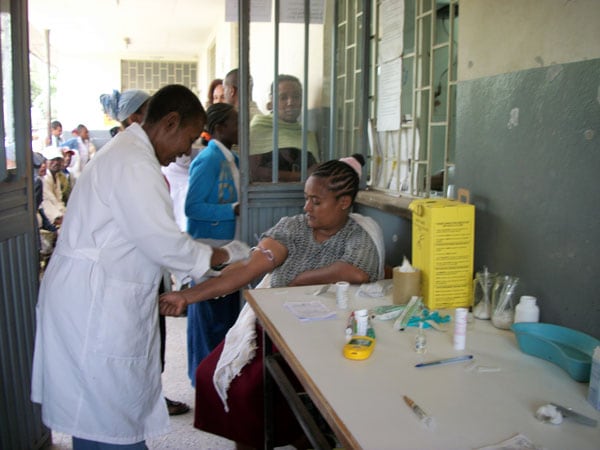Assessment of an integrated TB/HIV programme at health facilities in Hawassa town administration of Ethiopia
 |
| Photo@CDC |
Abstract:
Evaluation of health programmes is essential to assist programme managers in decision-making and accountability to the population they serve. Additionally, regular monitoring and evaluation of TB/HIV collaborative activities are used as a means to assess quality, effectiveness and coverage of services; yet little attention has been given to this in most developing countries.
In the southern region of Ethiopia, since the inception of the TB/HIV collaborative activities in 2005, there has not been any formal evaluation pertaining to the implementation status of
integrated TB/HIV services at routine program level. However, a series of TB/HIV reviews underlined many challenges that have adversely affected the implementation nationally. However, studies conducted on the quality of TB and HIV/AIDS services tend to be broad and not targeted to the integrated TB/HIV program and therefore, it was necessary to assess the implementation status in a more focused way with a vision to determine its adequacy or otherwise and make appropriate recommendations to improve integrated TB/HIV services in the town.
Aim: To assess the implementation of integrated TB/HIV activities in the health facilities of Hawassa town administration Study design: Cross sectional study
Study population: All health facilities, health managers, and records of TB and HIV patients in Hawassa town administration Sample population: The study population encompassed TB and HIV clinics, managers of each health facility, and sampled records of individual clients/patients enrolled in the HIV/AIDS/TB treatment and care program, from each health facility in the year 2009/10. Data collection: Face-to-face interviews with facility managers, observation of the rooms in which TB/HIV services are rendered and a review of patient records, were undertaken.
Analysis: Descriptive statistics with frequencies and percentages were used for analysis of
facility based resource inputs, TB case finding and management, and HIV case finding and management practices. Indicator variables extracted from the record review were transformed into scales (0 or 1) and weighted to reflect the levels of TB/HIV service quality, integration and resources input. After weighting, experts' opinion was used to set a cut off level (75%) to categorize the relative service quality received by individuals and the level of integrated care provided by facilities into "adequate" or "inadequate". Bivariate analysis was done to assess the effect of independent predictor variables on outcome variables. We used a– P value of 0.1 on bivariate analysis as the cut off point for inclusion of variables into the multivariate analysis. Prevalence ratios, adjusted prevalence odds ratios, and 95% confidence intervals were used to present outcomes.
Results: Availability of resource inputs for HIV/AIDS care was inadequate in half of the facilities in Hawassa town whereas, laboratory infrastructure for TB/HIV care was adequate in
all facilities. Most (91%) HIV/AIDS patients had their CD4 count and weight (96%) measured at baseline. However, the trend declined over time and the practice was better in hospitals than in health centres. HAART status was a strong predictor of CD4 count improvement and improvement in CD4 count was found to be a strong predictor of body weight gain. TB case finding and management practices in HIV/AIDS clinics were found to be adequate in the health facilities in Hawassa town.
Ninety five percent and 86% of HIV positive patients were screened for TB at baseline and at the last clinical visit respectively, of which 98%, 93% and 81% of
patients co infected with TB and HIV were provided with DOTS, CPT and ART respectively. However, only 11% of HIV positive patients without active TB were provided with IPT. Only HAART status was found to be a strong predictor of TB case finding. Quality of HIV/AIDS care in health facilities in Hawassa town was adequate. Availability of at least a minimum number of staff and being on HAART were found to be strong negative and positive predictors of quality respectively. Overall, 91% of patients on HAART were retained in care at the end of the year (alive and on treatment), 6% were retained and 3% died. Resources for the TB program were deficient in our study area. Three out of four facilities had inadequate overall input resources required for good quality TB care and the fourth barely managed to achieve adequate status. However, laboratory infrastructure and availability of forms and registers were adequate in all the facilities. There was a high degree of HIV case finding and a high prevalence (17%) of HIV among TB patients. Despite this, the overall HIV care provided was inadequate, with only 64% and 73% of TB/HIV co-infected patients being provided with HAART and co-trimoxazole respectively and 22% of TB/HIV co-infected patients not enrolled in HIV care. Among sputum positive TB patients good quality TB care was found to be a strong predictor of successful treatment outcome Our study also showed consistently very high quality TB service provision in the town despite the lack of required resources.
Conclusion and Recommendations: The study showed that there was relatively good quality provision of TB and HIV services despite inadequate input resources and that quality of care was positively associated with good outcomes. The study also indicated that HAART benefited patients substantially and hence earlier initiation could be the way forward. We recommend that to further improve quality of care one stop shopping services (availing both anti-TB and HIV care at the same service point within a clinic) be established. In addition, we recommend improved patient monitoring, especially for Pre-ART patients, be established.




Comments
Post a Comment